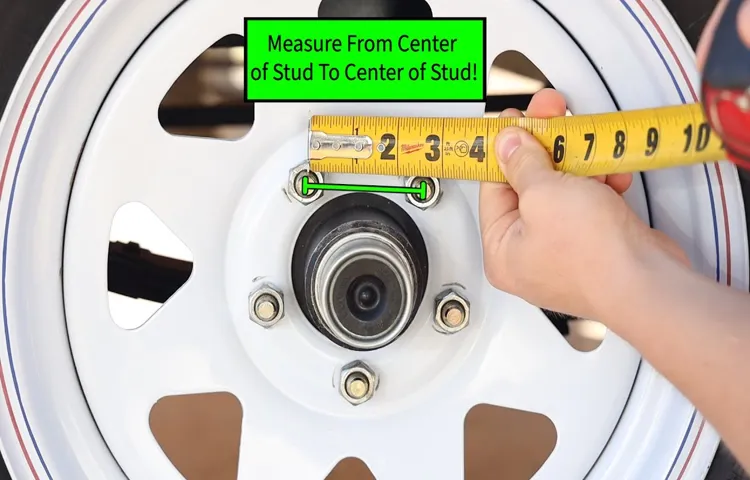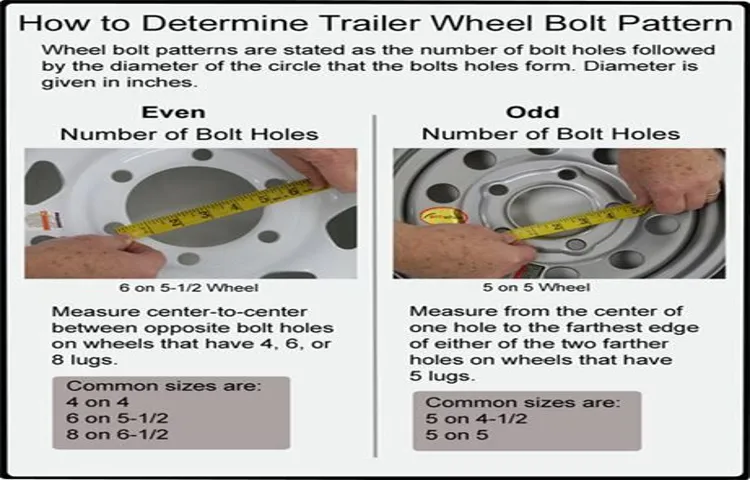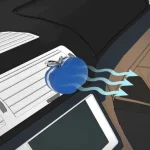Have you ever experienced the frustration of trying to find the right trailer tire to fit onto your wheel hub? With so many different sizes and types of trailer tire bolt patterns available, it can be difficult to know where to start. However, getting the correct measurements for your trailer tire bolt pattern is crucial for ensuring a perfect fit and preventing any potential safety hazards on the road. In this blog post, we will provide you with a step-by-step guide on how to measure your trailer tire bolt pattern, making your tire-shopping experience smoother and hassle-free.
So, let’s jump in and find out how to get the perfect fit for your trailer tires!
Table of Contents
Understanding bolt patterns
If you’re a trailer owner, understanding bolt patterns is essential for ensuring the safest and most efficient use of your rig. The bolt pattern of your trailer tire refers to the number of bolts and the spacing between them required for your tire to fit your trailer correctly. To measure your trailer tire’s bolt pattern, first, find out how many bolts your trailer has.
Then, measure the distance between two adjacent bolts across the center of the wheel. Typically, bolt patterns are expressed in terms of a two-number format, such as 5×5, where the first number represents the number of bolts and the second number represents the diameter of the bolt circle in inches.
With this information on hand, you can purchase new trailer tires with the correct bolt pattern. It’s also crucial to ensure that the bolt pattern of your trailer and the wheels match precisely to avoid unsafe driving conditions, tire wear, or damage to your trailer’s axles. By measuring and understanding bolt patterns, you can ensure that your trailer is equipped with suitable tires that provide the maximum performance and safety, and towing your rig becomes more comfortable and enjoyable.
What is a bolt pattern?
Bolt pattern Have you ever wondered what a bolt pattern is and why it’s important? A bolt pattern is the arrangement of bolts on a wheel or hub that secures the wheel to the vehicle’s axle. It is expressed as two numbers indicating the number of bolts and the diameter of the circle they form. For example, a bolt pattern of 5×11
3 means that there are five bolts and the diameter of the circle they form is 113 millimeters. Bolt patterns are crucial because they ensure that the wheels are properly mounted to the vehicle and that they are aligned correctly, ensuring a safe and smooth ride.
In addition, bolt patterns can affect the style and appearance of your vehicle, as different vehicles have different bolt patterns. So, if you want to upgrade your wheels or tires, it’s essential to know your vehicle’s bolt pattern to ensure a proper fit.

How do bolt patterns work?
Bolt patterns may seem like a complex concept, but they are actually quite simple once you understand how they work. A bolt pattern refers to the number of bolt holes and the distance between them on a wheel. This is important because it determines whether a wheel will fit on a particular vehicle.
The bolt pattern is usually expressed in a set of two numbers, such as 5×113, where the first number represents the number of bolt holes and the second number represents the diameter of the circle that the bolt holes form. For example, in a 5×11
3 bolt pattern, there are 5 bolt holes and the diameter of the circle they form is 113 millimeters. It’s important to note that bolt patterns are specific to each vehicle make and model, so it’s essential to find the correct bolt pattern before purchasing new wheels.
Understanding bolt patterns will ensure that you find the perfect fit for your vehicle and avoid any unnecessary headaches.
Types of bolt patterns
Bolt patterns are an important aspect to consider when purchasing new wheels for your vehicle. A bolt pattern is simply the arrangement of bolts around the hub of the wheel that attaches it to your car. There are several types of bolt patterns including four-lug, five-lug, six-lug, and eight-lug patterns.
The most common bolt pattern is a five-lug pattern, which is used on many cars and trucks. Understanding your vehicle’s bolt pattern is crucial for ensuring proper fitment of your new wheels. When selecting wheels, it’s important to choose ones that match your vehicle’s bolt pattern and offset to guarantee a safe and secure fit.
Therefore, it’s recommended to consult with an expert or refer to your vehicle’s owner manual to determine your bolt pattern and select wheels accordingly. By understanding and selecting the appropriate bolt pattern, you can elevate the appearance and performance of your vehicle.
Measuring bolt patterns
If you’ve ever needed to replace trailer tires or upgrade your wheels, you’ll need to measure the bolt pattern. And if you’re not sure how to do that, don’t worry! Measuring trailer tire bolt patterns is easy. First, count the number of bolts or lug nuts on the wheel.
Then, measure the distance between the center of two adjacent bolts. You’ll need to measure from the center of one bolt to the center of the bolt directly across from it. Make sure to measure accurately and avoid measuring from the edges of the bolts.
Once you have this measurement, you can match up your bolt pattern with the correct tire or wheel. So there you have it! Measuring your trailer tire bolt pattern is a simple task that will make replacing your trailer’s tires or wheels a breeze.
Tools needed for measuring bolt patterns
Measuring bolt patterns on a wheel is essential when you want to ensure that the nut pattern on a new set of wheels will fit your vehicle. One of the most useful tools for measuring bolt patterns is a digital caliper. A digital caliper is an absolute necessity for measuring bolt patterns since it has a high degree of accuracy to determine the exact distance between two opposite studs on the wheel.
Besides, using a circular bolt pattern template can help to measure bolt patterns of multiple stud sizes such as the 4, 5, and 6 lug patterns. It’s a straightforward method and will save you time and effort. Other tools that may be used to measure bolt patterns include a tape measure, a bolt pattern gauge.
However, the simplest and most reliable way to measure bolt patterns is to use a bolt pattern gauge. Using the right tool to measure bolt patterns is essential for a successful wheel replacement.
Step-by-step instructions for measuring bolt patterns
If you’re looking to replace or upgrade the wheels on your vehicle, you’ll need to know the bolt pattern to ensure a proper fit. Measuring bolt patterns may seem daunting, but it’s actually quite simple. The first step is to determine the number of bolts on your wheel hub.
Next, measure the distance between the bolts, also known as the pitch circle diameter (PCD). This is done by measuring from the center of one bolt hole to the center of the opposite bolt hole. Once you have these measurements, you can use a bolt pattern guide or chart to determine the bolt pattern.
Remember, accuracy is key when measuring bolt patterns, so take your time and double-check your measurements. With these simple steps, you’ll be able to confidently find the right wheels for your vehicle.
Measuring bolt patterns with an odd number of lugs
Measuring Bolt Patterns Measuring bolt patterns with an odd number of lugs can be a bit tricky. Unlike even-numbered lugs, you can’t just measure the distance between two diagonally opposite studs to determine the bolt pattern. When it comes to an odd number of lugs, things get a bit more complicated.
To measure the bolt pattern of an odd number of lugs, you need to first identify the lug that is directly across from the one you are measuring. Once you have found this opposite lug, measure the distance between the two. Next, you’ll need to measure the distance between the adjacent lugs, or lugs that are next to each other.
Finally, you’ll have all the measurements you need to determine the bolt pattern. Simply divide the distance between the opposing lugs by 154, and then divide the distance between adjacent lugs by
41 This will give you the bolt pattern measurement, which you can use when purchasing new rims or wheels for your vehicle. So, the next time you need to measure an odd number of lug bolt pattern, remember to identify the opposite lug, measure the distance between the adjacent lugs, and use the appropriate division ratios to calculate the bolt pattern.
Double checking your measurements
When measuring the bolt pattern of your trailer tire, it’s crucial to double check your measurements to ensure accuracy. A mistake in measuring could result in buying the wrong size tire or wheel, which can be a costly error. To measure the bolt pattern correctly, take note of the number of lugs and the distance between them.
Begin by measuring from the center of one lug to the center of the opposite lug directly across from it. This distance will give you the bolt pattern’s diameter, which can be used to find the number of bolts. Count the lugs on the hub to determine the exact number, and you have your bolt pattern.
It’s best to measure twice to avoid any confusion or mistakes. By taking the time to double check your measurements, you’ll save yourself time and money in the long run.
Common mistakes when measuring bolt patterns
When it comes to measuring bolt patterns, double checking your measurements is crucial to avoid common mistakes. It may seem like a simple task, but even the slightest measurement error can have a significant impact on the fit and function of your bolts. One common mistake is measuring the bolt circle diameter instead of the bolt pattern diameter.
The bolt circle diameter is the measurement from the center of one bolt hole to the center of the opposite bolt hole, while the bolt pattern diameter is the measurement from the center of one bolt hole to the center of the next bolt hole. Another mistake is miscounting the number of bolt holes, which can lead to the wrong bolt pattern being identified. It’s also important to ensure that the measuring tool being used is accurate and reliable.
Taking the time to double check your measurements can save you time, money, and a headache in the long run.
How to double check your bolt pattern measurement
When it comes to ensuring your bolt pattern measurement is accurate, double checking is key. Before ordering new wheels or tires, it’s important to double check your measurement to avoid any costly mistakes. One easy way to do this is to measure the distance between the center of two adjacent bolt holes on the wheel, in millimeters.
Then, count the number of bolt holes. This will give you your bolt pattern measurement, such as 5×11 Once you have this measurement, it’s a good idea to double check by measuring across the center of two opposite bolt holes.
If the measurement matches your original calculation, then you can be confident that you have the correct bolt pattern measurement for your vehicle. Remember, taking the time to double check your measurement can save you time, money, and frustration down the road.
Conclusion
By following these simple steps, you now know how to measure your trailer tire bolt pattern with ease. Remember, it’s always better to be safe than sorry when it comes to your tires. So, don’t be a square, get out your trusty tape measure and get measuring! Happy towing!”
FAQs
What tools do I need to measure my trailer tire bolt pattern?
You’ll need a tape measure, a ruler, or a bolt pattern gauge to get an accurate measurement.
How do I measure the bolt pattern of my trailer tire?
Start by finding the center of the wheel, then measure the distance between the centers of two adjacent bolt holes. Repeat this process for bolt holes across from each other. The measurement you get will be the bolt pattern of your tire.
What if my trailer has an odd-numbered bolt pattern?
If your trailer has an odd-numbered bolt pattern, you’ll need to measure from the center of one bolt hole to the edge of the bolt hole furthest from it. Then, measure the distance between the two closest edges of bolt holes across from each other. Add these two measurements together to get your bolt pattern.
How do I know if my measurement is correct?
You can double-check your measurement by comparing it to the specifications provided by the tire manufacturer or by consulting an expert.
What happens if I put the wrong sized tire on my trailer?
Using the wrong sized tire could cause your trailer to handle poorly, and it could also damage your tire, rim, and wheel bearings.
Can I use a different bolt pattern tire on my trailer?
No, you should always use a tire with the same bolt pattern as the one that came with your trailer.
How often should I check the bolt pattern of my trailer tire?
It’s a good idea to check your trailer tire bolt pattern at least once a year or whenever you replace a tire or wheel.



